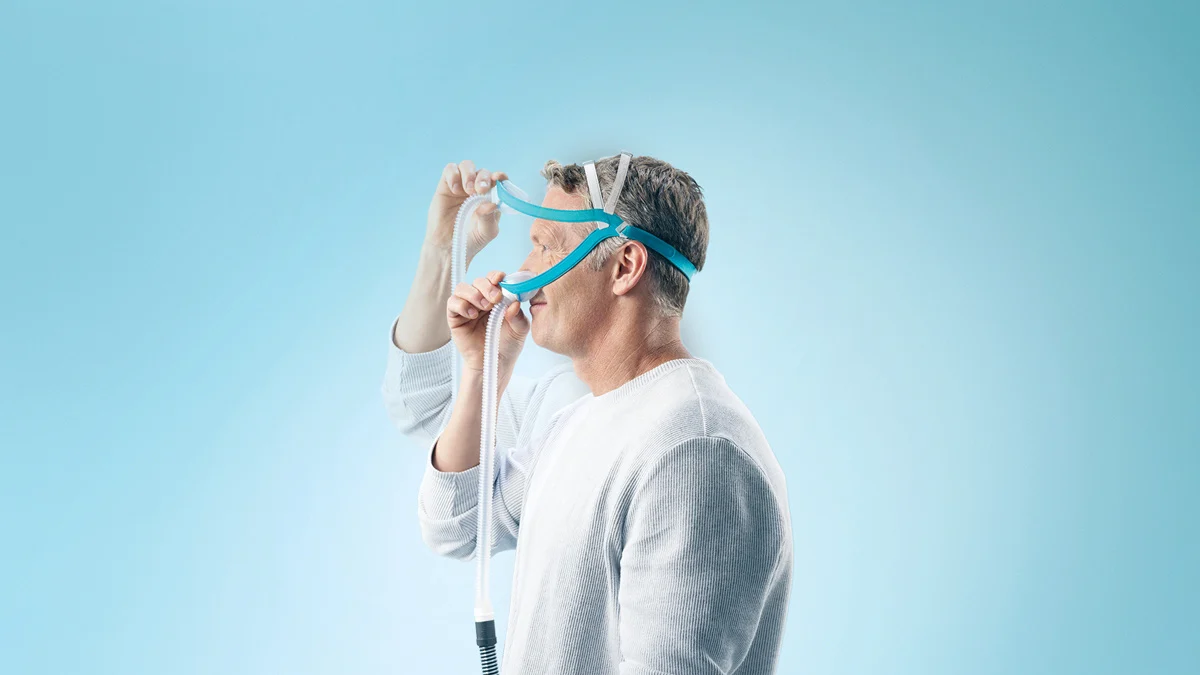If You Have Sleep Apnea, it’s Important to Adhere to Your Treatment. The First Step is to Get a Machine you Like!
PAP (positive airway pressure) is considered the “gold standard” of sleep apnea care. And for good reason: more than 8 million Americans enjoy the benefits of this proven effective treatment.
Studies show that PAP increases the quantity and quality of your sleep—and in the process, improves your overall health and well-being. If you have sleep apnea, regularly using a PAP machine can help improve your energy, blood pressure, and mood, and reduce daytime sleepiness.
Left untreated, sleep apnea can lead to serious health consequences, including stroke, heart attack, diabetes, and obesity.
States Apria Healthcare Vice President of Sleep Business Robert Miller, “To ensure that your treatment is a success, it’s critical that you choose the PAP device that is just right for you.”
Following are tips to help you do just that!
Get a Prescription and Keep It Up to Date
Before you can purchase a PAP, you’ll need a prescription from your doctor or healthcare team. Your doctor or team may recommend a sleep study to ensure an accurate diagnosis of sleep apnea.
Generally, there are two types of sleep studies:
Polysomnogram (PSG): This study is done at a sleep lab or sleep clinic over the course of one night. (It also can be conducted during the day for people who work at night.) As you sleep, special equipment records your brain waves, oxygen levels, heart rhythm, eye and leg movements, and airflow.
Home Sleep Test (HST): This is a modified type of sleep study that can be done in the comfort of your home. However, it records fewer body functions than a PSG. So, if you have an underlying health condition, your doctor will recommend a PSG sleep study.
PAP prescriptions have expiration dates, so it’s important to renew them every 12 months.
Choose a CPAP, BiPAP, or APAP Machine
Generally, these are the three types of PAP devices. Each employs a mask you wear over your nose or mouth. The mask is connected to a machine that delivers pressurized air to keep your airways open and help you breathe—and sleep—more easily.
Your doctor can help you select the most appropriate device for your specific sleep needs.
- CPAP (continuous positive airway pressure) delivers a constant flow of air at one pressure setting.
- BiPAP (bilevel positive airway pressure) delivers pressurized air at two alternating levels: one level when you inhale, another when you exhale.
- APAP (automatic positive airway pressure) automatically adjusts the amount of airway pressure when it detects breathing problems.
Check Your Settings
When properly set, your PAP device can help improve the quality and quantity of your sleep every night.
However, if the pressure is too low, you may wake up feeling unrefreshed, with an increased risk of high blood pressure, and experience heavy snoring, choking, or gagging,
If your PAP pressure is too high, you may feel extreme discomfort as you sleep, have difficulty exhaling, and experience a burning sensation in your throat
Your healthcare team can recommend the ideal PAP air pressure setting for you.
Ramp Up Comfort
Ramp is a feature where the PAP machine starts at a pressure so low, you barely notice it. The machine then increases pressure to your prescribed pressure setting as you sleep. For many people, this helps them fall asleep more easily.
Most current PAP machines have this feature, but not all. But sure to ask.
Keep the Humidity On
PAP machines can cause dryness of your mouth, nose, and throat. That’s because the pressurized air delivered by the machine reduces moisture in your nasal passages.
PAP heated humidifiers and tubing replace moisture in your nasal passages. They can also reduce the risk of nasal infections and bloody noses.
Like the ramp option, most, but not all, PAP machines have heated humidification and tubing, so ask before you buy.
Turn the Sound Down
If you and your partner are light sleepers, buy a PAP machine that operates quietly. Ideally, you want a device rated at 30 decibels (dB) or below (often referred to as the “whisper level”).
Adds Apria’s Robert Miller, “These devices are perfect for people who are particularly sensitive to noise.”
Track Your Data
Most modern PAP machines record such sleep data as length of sleep, pressure changes, snoring episodes, and sleep apnea events. This information is valuable to both you and your healthcare team. It may also be helpful to show insurers that you are adhering to therapy to ensure reimbursement.
Keep It Simple
Choose a PAP machine with a user interface that’s simple to use and provides easy access to your sleep data every morning. That way, you can adjust comfort settings as needed.
Work with Your Healthcare Team
Choosing a PAP machine is truly a collaborative effort between you and your care team, which includes Apria’s Sleep Coaches, who are experts in the treatment of sleep apnea.
Working together, you can select the make and model of a PAP machine that offers all the features you need—to help ensure you get the sleep you deserve.
References
1. Ellis, R. (2021, June 13). 8 Tips for Choosing a CPAP Machine. WebMD.
https://www.webmd.com/sleep-disorders/features/tips-for-choosing-cpap-machine.
2. Konkel, L. (2019, January 30). How to Choose and Use a CPAP Machine for Sleep Apnea. Consumer Reports. https://www.consumerreports.org/sleep-apnea/cpap-machine-for-sleep-apnea-how-to-choose-and-use/.
3. Capritto, A. (2019, July 3). CPAP machines: How to pick one you won't hate. CNET. https://www.cnet.com/health/sleep/cpap-machines-how-to-pick-one-you-wont-hate/.
LEGAL DISCLAIMER: Material in this newsletter is provided for general health education and informational purposes and to provide references to other resources only; it may not apply to you as an individual. While Apria Healthcare believes that the information provided through this communication is accurate and reliable, Apria Healthcare cannot and does not make any such guarantee. It is not intended to be a replacement for professional medical advice, evaluation, diagnosis, services or treatment (collectively, “medical treatment”). Please see your healthcare provider for medical treatment related to you and your specific health condition(s). Never disregard medical advice or delay seeking medical care because of something you have read on or accessed through this website. Reading this newsletter should not be construed to mean that you have a healthcare provider/patient relationship.

.png)



